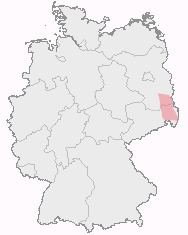Ethnicity Sorbs ISO 639-2 / 5 wen | Glottolog sorb1249 | |
 | ||
Linguistic classification Indo-EuropeanBalto-SlavicSlavicWest SlavicSorbian Subdivisions Upper SorbianLower Sorbian | ||
The Sorbian languages (Upper Sorbian: Serbsce; Lower Sorbian: Serbski) are two closely related languages spoken by the Sorbs, a Slavic minority in the Lusatia region of eastern Germany. They are classified under the West Slavic branch of the Indo-European languages. Historically the languages have also been known as Wendish or Lusatian. Their collective ISO 639-2 code is wen. They are closely related to Polish, Kashubian, Czech and Slovak.
Contents
There are two literary languages: Upper Sorbian (hornjoserbsce), spoken by about 40,000 people in Saxony, and Lower Sorbian (dolnoserbski) spoken by about 10,000 people in Brandenburg. The area where the two languages are spoken is known as Lusatia (Łužica in Upper Sorbian, Łužyca in Lower Sorbian, or Lausitz in German).
History
After the settlement of the formerly Germanic territories (the part largely corresponding to the former East Germany) by the Sorbs' Slavic ancestors in the 5th and 6th centuries, the Sorbian language (or its predecessors) had been in use in much of what was the southern half of East Germany for several centuries, and still had its stronghold in (Upper and Lower) Lusatia, where it enjoys national protection and fostering to the present day. Outside Lusatia, it has been superseded by German, following official discrimination from the 13th century on. The printed language developed around the main Bible translations into Sorbian.
Geographic distribution
In Germany, Upper and Lower Sorbian are officially recognized and protected as minority languages. In the home areas of the Sorbs, both languages are recognized as second official language next to German.
The city of Bautzen in Upper Lusatia is the centre of Upper Sorbian culture. Bilingual signs can be seen around the city, including the name of the city, "Bautzen/Budyšin".
The city of Cottbus (Chóśebuz) is considered the cultural centre of Lower Sorbian; here too bilingual signs are found.
Sorbian has also been spoken in the small Sorbian ("Wendish") settlement of Serbin in Lee County, Texas, and it is possible that a few speakers still remain there. Until recently newspapers were published in Sorbian there. The local dialect has been heavily influenced by surrounding speakers of German and English.
While the old German-derived labels "Wend" and "Wendish", which once denoted "Slav(ic)" generally, have been retained in American and Australian communities, they are today mostly unusual in place of "Sorb" and "Sorbian" with reference to Sorbian communities in Germany, because many Sorbs consider such words to be offensive.
Linguistic features
Both Upper and Lower Sorbian have the dual for nouns, pronouns, adjectives and verbs; very few living Indo-European languages retain this as a productive feature of the grammar. For example, the word ruka is used for one hand, ruce for two hands, and ruki for more than two hands. As with most of the Slavic languages, Sorbians uses no articles.
Grammar
The Sorbian languages are declined in six to seven cases:
- Nominative
- Accusative
- Dative
- Genitive
- Instrumental
- Locative
- Vocative (Upper Sorbian only)
Vocabulary comparison
The following is selected vocabulary from the two Sorbian languages compared with other Slavic languages.
